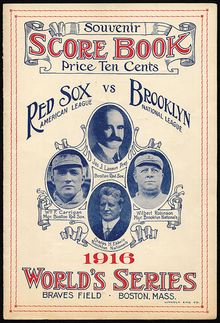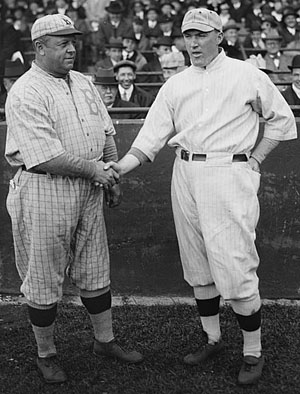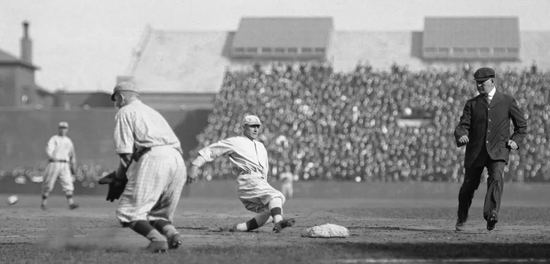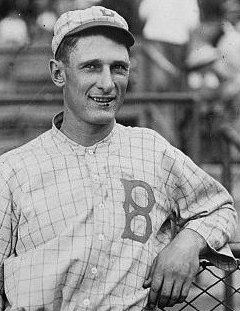|
Pivotal World Series Moments
"When in doubt, hit to Ivy."
1916 World Series Game 1: Brooklyn Robins @ Boston Red Sox
30-year-old Ivy Olson was the shortstop of Wilbert Robinson's Brooklyn Robins, who won the National League pennant by 2.5 games over the defending champion Phillies despite Olson committing 48 errors, which tied for fourth most in the league. Frank Graham described Olson this way: "Olson wasn't a very good mechanical player, but he was smart and hard and tough, as as game as anybody that ever lived." He would need all those traits in the World Series.
The American League champion Red Sox knew Olson from his stint with Cleveland from 1911-14. The Boston dugout taunted him by yelling, "When in doubt, hit it to Ivy." According to Babe Ruth, "we had him crazy before (the Series) was over. At one stage of the Series, he said he'd lick our whole ball club. Of course, we only greeted him with laughs, and the more we laughed, the madder he became, and the madder he became, the worse he played."
  Wilbert Robinson and Bill Carrigan Olson would commit four errors in the five Series games. Several of the miscues helped Boston win games.
Surprise Boston Starter
Red Sox manager Bill Carrigan surprised the crowd of 36,117 gathered at Braves Field for Game One by choosing Ernie Shore (16-10, 2.63) to fling for the defending champions instead of Babe Ruth (23-12, 1.75). Carrigan made his decision while watching the two southpaws warming up in front of the Boston dugout. He favored Shore because he had World Series experience in 1915.
 Tillie Walker slides into third with a triple in the first inning of Game 1. The choice looked inspired as Shore held the Robins to just one run in eight innings. Meanwhile, the Red Sox got to Rube Marquard for a run in the third and another in the fifth.
A great play by Boston RF Harry Hooper saved a run in the fourth. Brooklyn RF Casey Stengel led off with a single to left field. LF Zach Wheat then tripled home Stengel. 2B George Cutshaw lofted a fly ball into short right field. Hooper tore under the fly and caught the ball while in a kneeling position. He then got to his feet and nailed Wheat at the plate.
Hooper Saves a Run
The Red Sox seemingly put the game away with three runs in the 7th, two of which were unearned. 2B Hal Janvrin led off with a double. Then CF Tillie Walker hit a grounder straight at SS Olson. Thinking of making a play on Walker heading to third, Ivy booted the ball to put runners on the corners. Then 1B Dick Hoblitzell bounced to 2B George Cutshaw, who fumbled the ball as Janvrin scored. After LF Duffy Lewis sacrificed the runners to second and third, 3B Larry Gardner bounced to Cutshaw, who threw wide to the plate as Walker scored to make it 4-1. SS Everett Scott drove home the third and final run of the frame with a sacrifice fly to Stengel.
   L-R: Ivy Olson, Ernie Shore, Babe Ruth, Rube Marquard Stengel's Error Gives Insurance Run
The Red Sox added an insurance tally in the eighth that turned out to be the difference in the game. With one out, Hooper walked. Janvrin slashed a single to right field. Stengel fielded the ball and threw badly to third trying to get Hooper, who continued home to make it 6-1. The extra run would prove to be the difference in the final score.
Mays Saves Red Sox
Shore fell apart in the ninth. Two walks, two singles, a hit batsman, and an error led to three runs and brought submariner Carl Mays in from the bullpen. After a single cut the margin to 6-5, Mays got 1B Jake Daubert to groundout to end the game.
References
The Brooklyn Dodgers: An Informal History, Frank Graham (1945) |